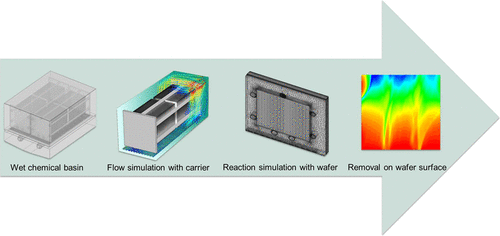当前位置:
X-MOL 学术
›
Ind. Eng. Chem. Res.
›
论文详情
Our official English website, www.x-mol.net, welcomes your feedback! (Note: you will need to create a separate account there.)
Numerical Simulation of an Entire Wafer Surface during Ozone-Based Wet Chemical Etching
Industrial & Engineering Chemistry Research ( IF 4.2 ) Pub Date : 2020-09-16 , DOI: 10.1021/acs.iecr.0c03382 Lena Mohr 1 , Tobias Dannenberg 1 , Anamaria Moldovan 1 , Martin Zimmer 1 , Claas Müller 2
Industrial & Engineering Chemistry Research ( IF 4.2 ) Pub Date : 2020-09-16 , DOI: 10.1021/acs.iecr.0c03382 Lena Mohr 1 , Tobias Dannenberg 1 , Anamaria Moldovan 1 , Martin Zimmer 1 , Claas Müller 2
Affiliation

|
In microelectromechanical system manufacturing and especially in the photovoltaic industry, wet-chemical baths are used for surface structuring, conditioning, and cleaning. Ozone-based wet-chemical cleaning processes show, in addition to the cleaning of the silicon wafers, the ancillary effect of intended material etch back. Previous studies observed inhomogeneities over the wafer surface occurring during the ozone-based wet chemical process. Since a detailed observation during the process in the basin is not possible, simulations are carried out to understand what causes these inhomogeneities. Therefore, an existing microscopic two-dimensional (2D) model for reaction modelling is extended stepwise from a length of several microns to the full length of 157 mm of an industrial solar cell. Subsequently, the 2D model is transferred to a three-dimensional (3D) model. In addition, an initial water layer, originating from the previous rinsing step, and the movement of the handling system were taken into account for modeling. This approach allows the estimation of the etching process over an entire wafer surface for the first time and enables better understanding of the reasons for the inhomogeneities. The water layer in connection with the fast movement of the handling system and the masking, originating from carrier rods, leads to stripes on the wafer surface, shown by differences in reflection. As the water layer is not removed homogeneously, the occurring chemical reaction in the masked areas is delayed and results in an uneven etching of the wafer surface. The removal over the entire wafer surface in the simulation (8.51 ± 0.37 nm) is in accordance with the experimental data (9.02 ± 1.10 nm). This presented model can serve as a base for future work to estimate the effects of parameter changes, e.g., plant design or the composition of the etching solution on the homogeneity of the wet chemical cleaning and etch back process, thus enabling a cost efficient process optimization.
中文翻译:

基于臭氧的湿法化学蚀刻过程中整个晶片表面的数值模拟
在微机电系统的制造中,尤其是在光伏工业中,湿化学浴被用于表面结构化,修整和清洁。基于臭氧的湿法化学清洗工艺除清洗硅片外,还显示出所需材料回蚀的辅助作用。先前的研究观察到在基于臭氧的湿化学工艺过程中,晶片表面出现了不均匀性。由于在盆地进行过程中不可能进行详细的观察,因此进行模拟以了解是什么原因造成了这些不均匀性。因此,现有的用于反应建模的微观二维(2D)模型从几微米的长度逐步扩展到了工业太阳能电池的157毫米的全长。后来,2D模型将转换为三维(3D)模型。此外,建模时还考虑了源自先前冲洗步骤的初始水层以及处理系统的运动。这种方法允许首次估计整个晶片表面上的蚀刻过程,并可以更好地理解不均匀的原因。源于承载杆的水层与处理系统的快速运动和掩膜有关,导致晶片表面出现条纹,如反射差异所示。由于不能均匀地去除水层,所以在掩模区域中发生的化学反应被延迟并且导致晶片表面的蚀刻不均匀。模拟中整个晶片表面的去除率(8.51±0。37 nm)符合实验数据(9.02±1.10 nm)。这个提出的模型可以作为未来工作的基础,以评估参数变化的影响,例如工厂设计或蚀刻溶液的成分对湿法化学清洗和回蚀过程的均匀性的影响,从而实现经济高效的过程优化。
更新日期:2020-10-07
中文翻译:

基于臭氧的湿法化学蚀刻过程中整个晶片表面的数值模拟
在微机电系统的制造中,尤其是在光伏工业中,湿化学浴被用于表面结构化,修整和清洁。基于臭氧的湿法化学清洗工艺除清洗硅片外,还显示出所需材料回蚀的辅助作用。先前的研究观察到在基于臭氧的湿化学工艺过程中,晶片表面出现了不均匀性。由于在盆地进行过程中不可能进行详细的观察,因此进行模拟以了解是什么原因造成了这些不均匀性。因此,现有的用于反应建模的微观二维(2D)模型从几微米的长度逐步扩展到了工业太阳能电池的157毫米的全长。后来,2D模型将转换为三维(3D)模型。此外,建模时还考虑了源自先前冲洗步骤的初始水层以及处理系统的运动。这种方法允许首次估计整个晶片表面上的蚀刻过程,并可以更好地理解不均匀的原因。源于承载杆的水层与处理系统的快速运动和掩膜有关,导致晶片表面出现条纹,如反射差异所示。由于不能均匀地去除水层,所以在掩模区域中发生的化学反应被延迟并且导致晶片表面的蚀刻不均匀。模拟中整个晶片表面的去除率(8.51±0。37 nm)符合实验数据(9.02±1.10 nm)。这个提出的模型可以作为未来工作的基础,以评估参数变化的影响,例如工厂设计或蚀刻溶液的成分对湿法化学清洗和回蚀过程的均匀性的影响,从而实现经济高效的过程优化。



























 京公网安备 11010802027423号
京公网安备 11010802027423号